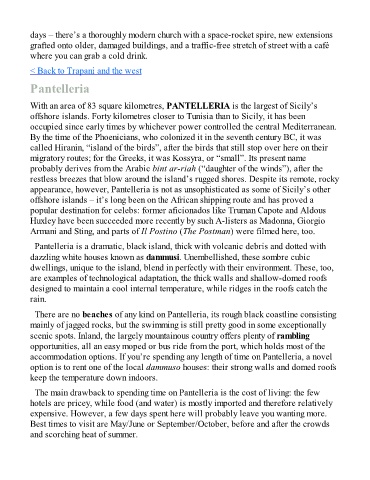Page 545 - The Rough Guide of Sicily
P. 545
days – there’s a thoroughly modern church with a space-rocket spire, new extensions
grafted onto older, damaged buildings, and a traffic-free stretch of street with a café
where you can grab a cold drink.
< Back to Trapani and the west
Pantelleria
With an area of 83 square kilometres, PANTELLERIA is the largest of Sicily’s
offshore islands. Forty kilometres closer to Tunisia than to Sicily, it has been
occupied since early times by whichever power controlled the central Mediterranean.
By the time of the Phoenicians, who colonized it in the seventh century BC, it was
called Hiranin, “island of the birds”, after the birds that still stop over here on their
migratory routes; for the Greeks, it was Kossyra, or “small”. Its present name
probably derives from the Arabic bint ar-riah (“daughter of the winds”), after the
restless breezes that blow around the island’s rugged shores. Despite its remote, rocky
appearance, however, Pantelleria is not as unsophisticated as some of Sicily’s other
offshore islands – it’s long been on the African shipping route and has proved a
popular destination for celebs: former aficionados like Truman Capote and Aldous
Huxley have been succeeded more recently by such A-listers as Madonna, Giorgio
Armani and Sting, and parts of Il Postino (The Postman) were filmed here, too.
Pantelleria is a dramatic, black island, thick with volcanic debris and dotted with
dazzling white houses known as dammusi. Unembellished, these sombre cubic
dwellings, unique to the island, blend in perfectly with their environment. These, too,
are examples of technological adaptation, the thick walls and shallow-domed roofs
designed to maintain a cool internal temperature, while ridges in the roofs catch the
rain.
There are no beaches of any kind on Pantelleria, its rough black coastline consisting
mainly of jagged rocks, but the swimming is still pretty good in some exceptionally
scenic spots. Inland, the largely mountainous country offers plenty of rambling
opportunities, all an easy moped or bus ride from the port, which holds most of the
accommodation options. If you’re spending any length of time on Pantelleria, a novel
option is to rent one of the local dammuso houses: their strong walls and domed roofs
keep the temperature down indoors.
The main drawback to spending time on Pantelleria is the cost of living: the few
hotels are pricey, while food (and water) is mostly imported and therefore relatively
expensive. However, a few days spent here will probably leave you wanting more.
Best times to visit are May/June or September/October, before and after the crowds
and scorching heat of summer.

